Research
Designing a mixed-initiative multi-user VR interface for wildfire mitigation
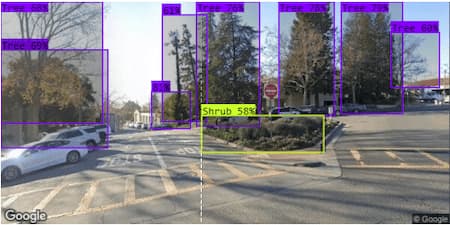
Wildfires in California are increasing in severity and frequency due to climate change. In collaboration with civil engineering researchers in the Soga Group at UC Berkeley, we are designing multi-user VR applications so groups of stakeholders can navigate simulations and datasets related to mitigating harm from wildfires. In the above image, we tested an object detection tool's capability for identifying vegetation, a component of modeling wildfire spread. Contributors to the report from the SET Lab are Samir Ghosh, Anthony Angeles, Andrew Moskovich, and Katherine Isbister. From the Soga Group are Yanglan Wang, Kecheng Chen, and Kenichi Soga. This report was accepted as a workshop paper to CHI ’23: HCI for Climate Change Imagining Sustainable Futures, April 28, 2023, Hamburg, Germany
#Social VRChasing Play on TikTok to Inspire Inclusive and Accessible Technology Design
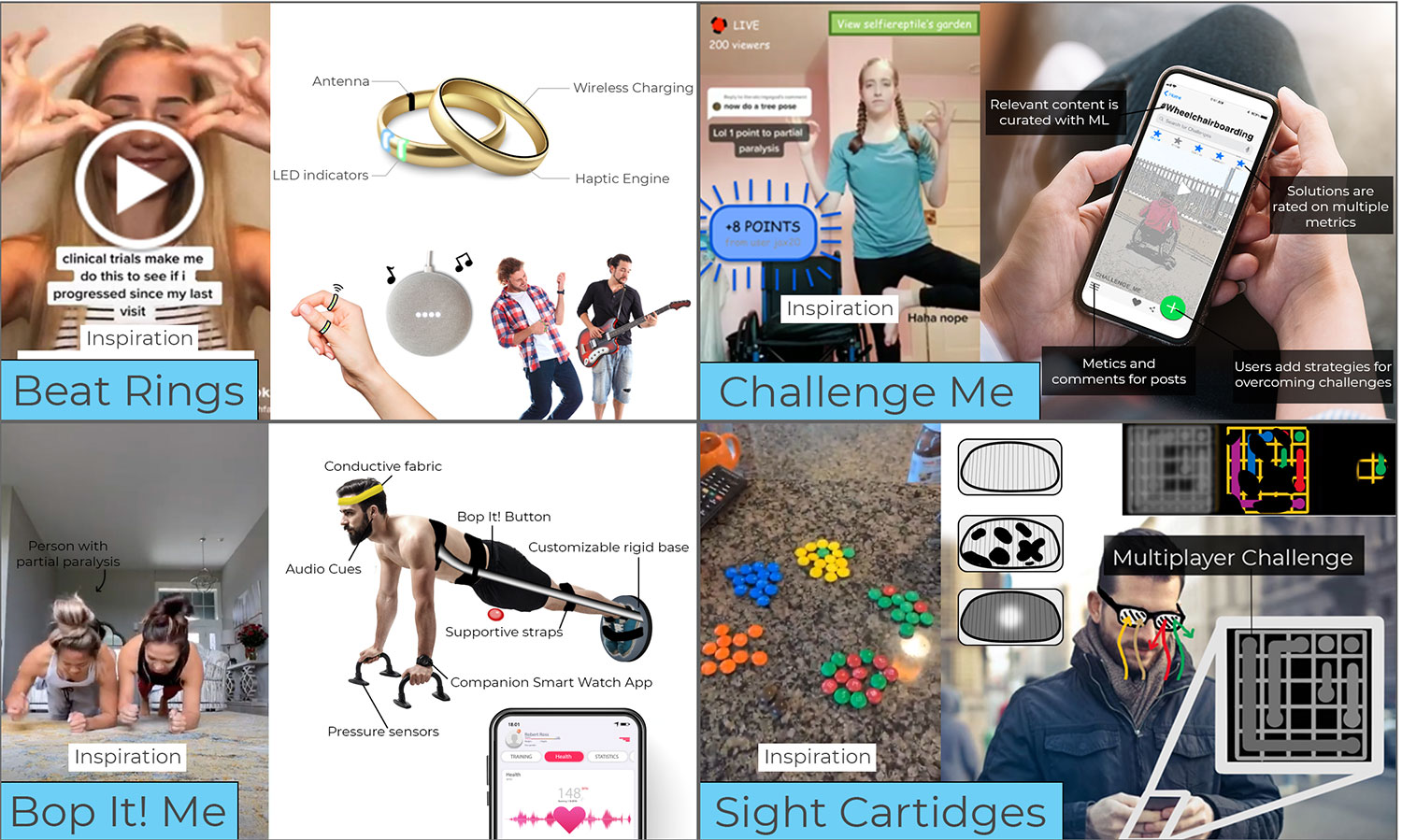
Social media is rife with tacit design knowlege—including content from creators with disabilities. In this work, we chased play potentials on TikTok from creators with disabilities to inspire accessible and playful everyday technology. We design better technology for everyone when we include the perspectives of people with disabilities early and often in the design process. This project was led by Jared Duval and co-authored with Ferran Altarriba Bertran, SIP High School Interns, and Katherine Isbister.
#DisabilityA Social Wearable that Affords Vulnerability
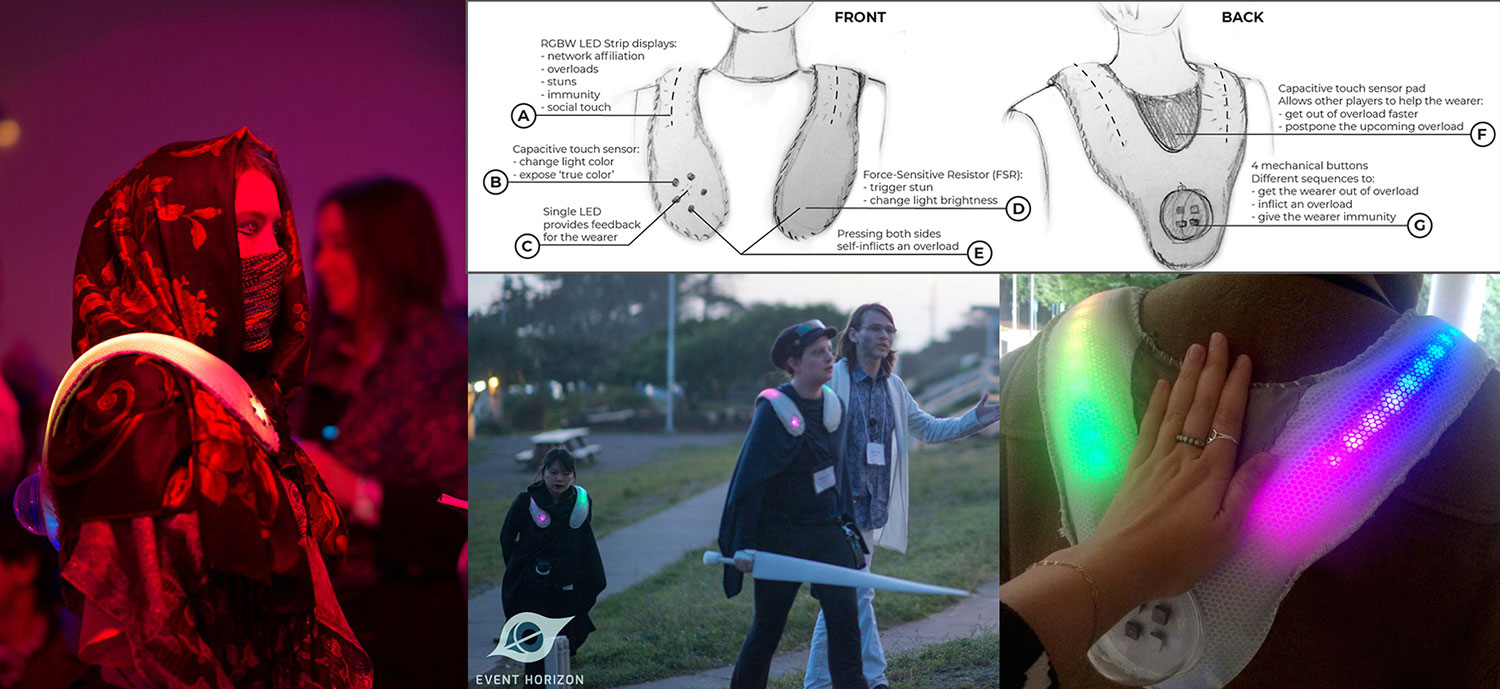
Vulnerability is a common experience in everyday life and is frequently perceived as a flaw to be excised in technology design. Yet, research indicates it is an essential aspect of wholehearted living among others. In this project we co-designed and deployed "True Colors", a novel wearable device intended to support social interaction in a live action roleplay game (LARP) setting. We followed a Research-through-Design process that helped us to discover and articulate the possibility space of vulnerability in the design of social wearables, as support for producing a sense of social empowerment and connection among wearers within the LARP. Our conclusions may be of value to others designing wearables and related technologies aimed at supporting co-located social interaction in games/play. This project was led by Ella Dagan and co-authored with Elena Márquez Segura, Ferran Altarriba Bertran, Miguel Flores, and Katherine Isbister. We collaborated with Event Horizon Larp crew.
#Social AugmentationDesigning Technological Interventions to Increase Communities’ Climate Resilience from the Bottom Up

Natural hazards, such as floods and wildfires, increasingly impact our lives severely, requiring everyone living in risk areas to become climate resilient. Human-Computer Interaction (HCI) research has explored climate change and sustainable user behavior but has yet to understand its role in developing and maintaining climate resilience. In this program, we have several ongoing projects aiming to design interventions that increase awareness of natural hazard risks and mitigation opportunities, use playful interaction experiences that increase engagement, compassion, and motivation, and tie into local resources, skills, and socio-cultural settings. Interim results show that technology is deeply entangled in the process of increasing climate resilience and empowering communities from the bottom up. However, there are also risks and dangers involved in potential misuse, fake news, etc. The work is highly relevant to bridging the last mile gap of enabling and empowering local communities to prepare for, deal with and bounce back from natural hazard impacts. Sidenote: Projects are partially under submission or still ongoing
#Community-driven Design#Climate ResilienceDesign Framework for Social Wearables
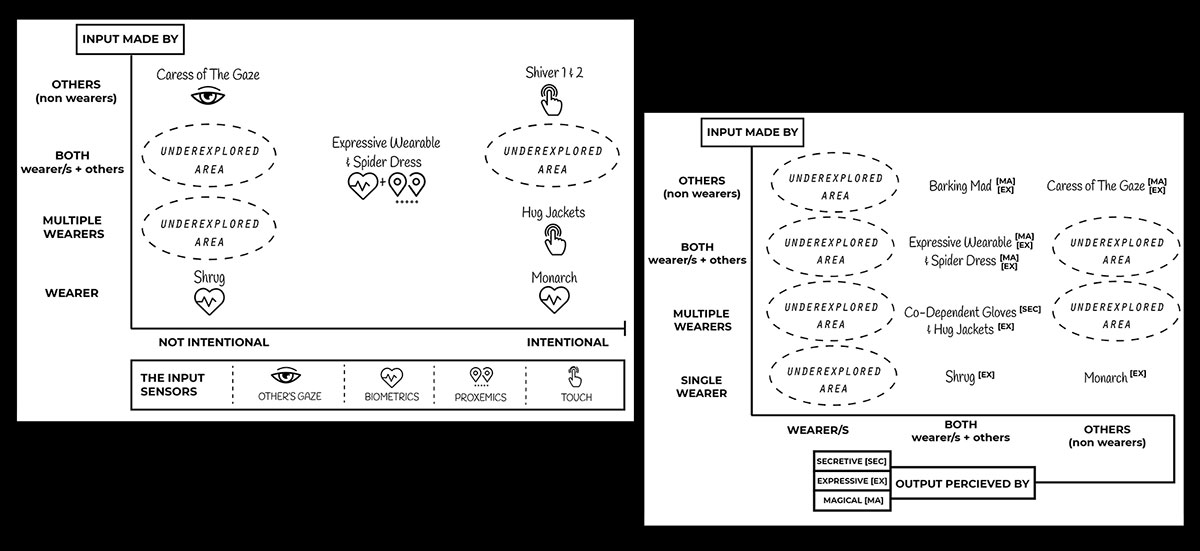
Wearables are integrated into many aspects of our lives, yet, we still need further guidance to develop devices that truly enhance in-person interactions, rather than detract from them by taking people’s attention away from the moment and one another. In this project we created an annotated portfolio of ‘social wearables’, namely technology designs worn on the body that augment co-located interaction. The design work we described can serve as inspiration for others. We then also propose a design framework for social wearables grounded in prior work, as well as our own design research, that can help designers to ideate by raising valuable questions to begin their inquiry with and use to evaluate their designs. We illustrate the evaluative value of this framework through two social wearable designs, each tested in the appropriate social setting. This project was led by Ella Dagan and co-authored with Elena Márquez Segura, Ferran Altarriba Bertran, Miguel Flores, Robb Mitchell, and Katherine Isbister.
#Social AugmentationWearables For Group Discussions
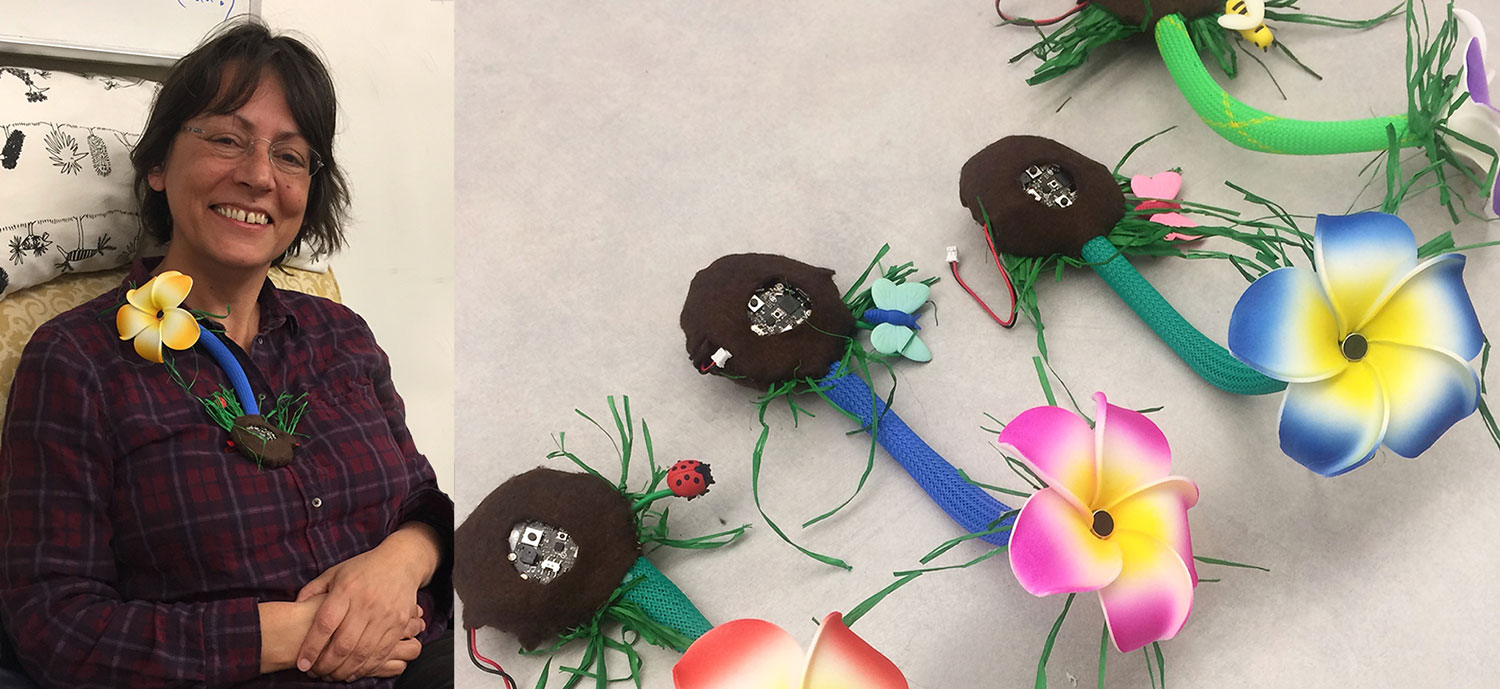
In this project we explored a social wearables prototype, i.e. a wearable that augments co-located social interaction: the Lågom. This design is meant to support people to be aware of and better regulate their verbal participation in group discussions. Lågom takes the shape of a colorful, bulky and funny looking flower that senses the wearer’s speaking and responds with haptic and visual feedback. We ran a pilot study with nine people participating in a class discussion. Preliminary results show potential of the haptic feedback to increase self awareness of participation, and to help people better regulate their participation in group discussions. This project was led by Ella Dagan and co-authored with Elena Márquez Segura, Miguel Flores and Katherine Isbister.
#Social AugmentationFlippo the Robo-Shoe-Fly: a Foot Dwelling Social Wearable Companion
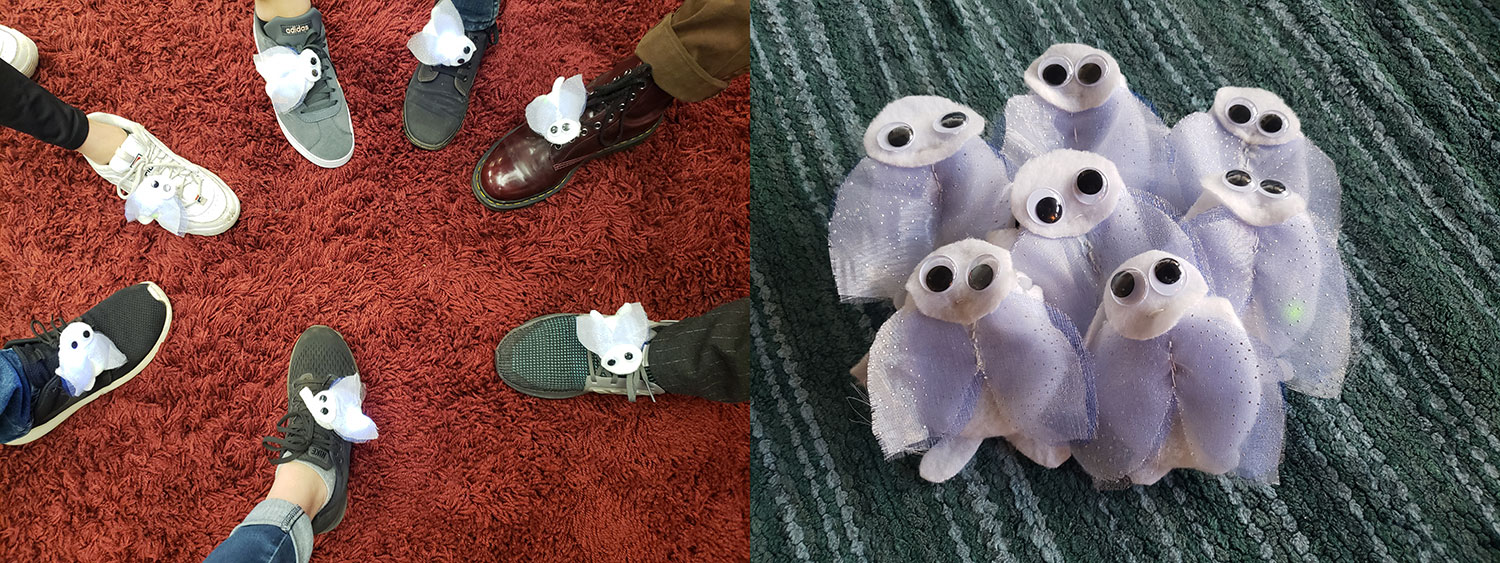
This project explores the design of a social wearble that is meant to support people to take breaks away from their desk and move, as well as to socialize with others by caring for their on-body companion 'robot'. Flippo takes the shape of a soft and fuzzy bug-like creature. It lives on people’s shoes and occasionally nudges them when it needs to move and have social interaction with another creature from its species. It does this by making sounds and visual effects, and requires that the wearers coordinate shaking their feet and helping the creatures face each other. If Flippo is satisfied with the interaction it displays a light animation and plays ’happy’ tunes, and if not it nudges the wearer again. We ran a field study with 13 participants, preliminary results show potential of the design to encourage and facilitate co-located social interaction. This project was led by Ella Dagan and co-authored with James Fey, Rachel Hsiao, Charlene Hoang, Sanoja Kikkeri, and Katherine Isbister.
#Social AugmentationSocial Wearables for LARP
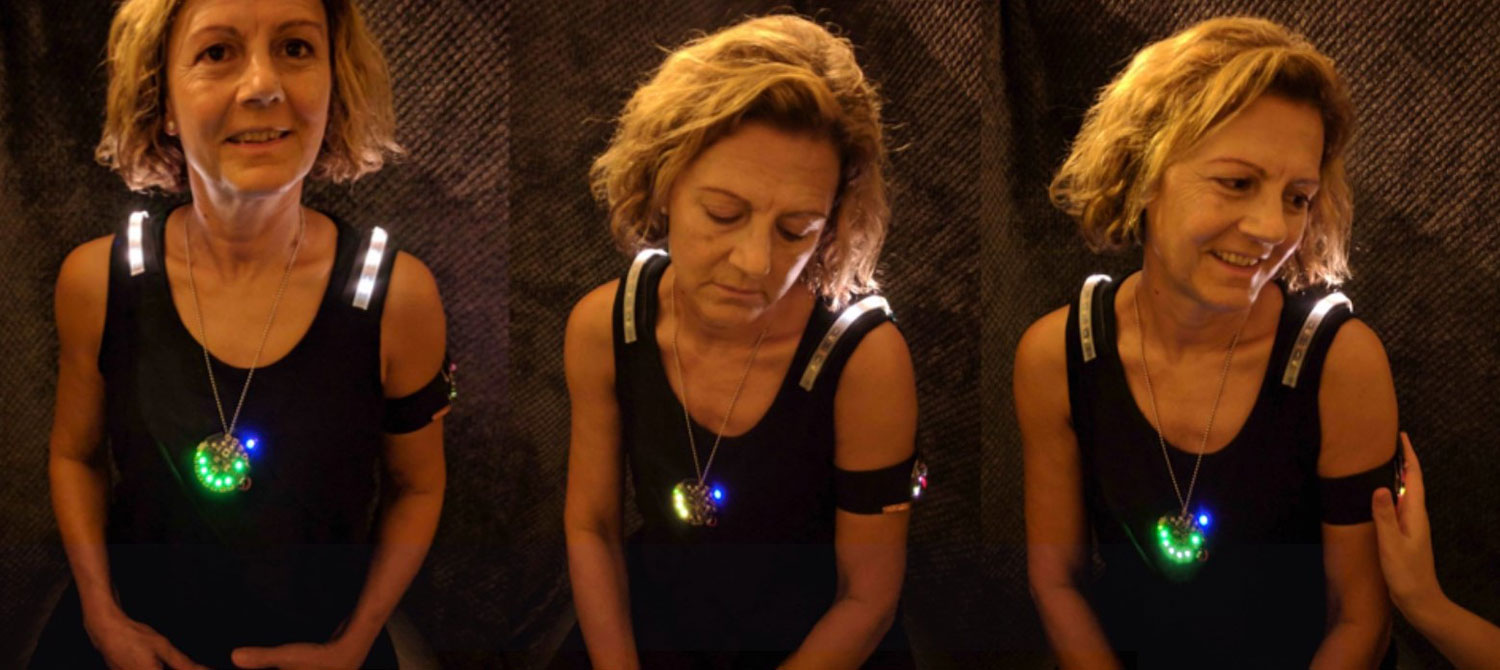
Designing wearable technology that supports physical and social engagement in a collocated setting is challenging. In this research, we reached out to an expert community of crafters of social experiences: larpers (live action role players). Larpers and larp designers have a longstanding tradition of designing and making use of a variety of elements, such as costumes, physical objects, environments, and recently also digital artifacts. These are crafted in support of co-experience values that we argue can inform the design of social wearables. We engaged in a co-design process with a game designer and co-founder of a larp production company, and embedded the resulting social wearables in a larp. Here, we present the results of this design and implementation process, and articulate design affordances that resonate with our larp designer's values. This work may inspire and inform researchers and designers creating wearable technology that is aimed at supporting collocated engagement.
#Social AugmentationSocial Wearables for Edu-LARP
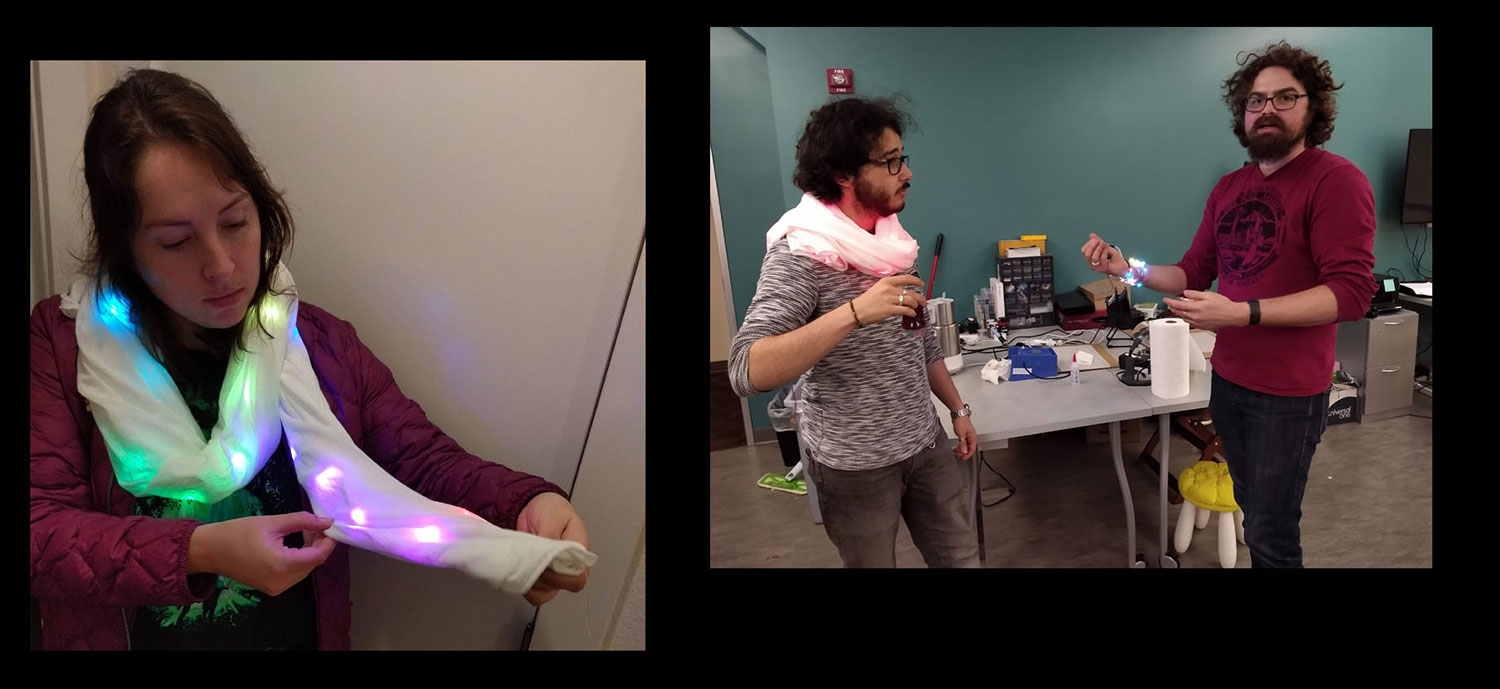
As part of our ongoing research into social wearables and combining them with the collaborative problem-solving nature of Live Action Role Play, we are designing an Educational LARP camp, aimed at a full-scale deployment by 2021. We aim to capitalize on the creative adaptation that comes from Live Action Role Play and the creation of social wearables to channel it into increased interest in Technology and Making in middle school girls, including those from lower socio-economic status and diverse backgrounds who are frequently left out of STEM. We have explored hardware and IDE options within the interconnected network of Maker ecosystems and created a prototype kit built around the BBC Micro:Bit ecosystem with an additional string of RGB LEDs. We have worked to find a form factor that offers a zero soldering fabrication and robust prototypes that are more suitable to wearable prototyping. In this paper, we discuss this early prototype and the motivation for the Educational LARP Camp.
#Social AugmentationSynergistic Social Technology: Designing Systems with ‘Needs’ that Encourage and Support Social Interaction
.jpg)
In this work we propose a strong concept for interaction design: Synergistic Social Technology (SST). This concept describes systems in which technology is designed with its own need for interaction. As a result of responding to these needs, people who use the system may benefit from social interaction with others who use the system. This concept arose through the design, prototyping, and study of a social wearable design that we called Robo-Shoe-Flies. We articulate the core principles of the SST concept. We also describe the Research-through-Design process that inspired its development and associated design-focused observations. This work may inspire those in the IxD or HCI communities focused on the design and development of technology intended to support so-cial interaction, particularly in the sense of encouraging collective, mutually-beneficial action. This project was led by Ella Dagan and co-author Katherine Isbister.
#Social AugmentationDrawing From Social Media to Inspire Increasingly Playful and Social Drone Futures
.jpg)
In this project, we created a pictorial where we explore the potential of social media to help inspire ideas for future drone design applications that support playful and social experiences. Drawing from a Situated Play Design approach, we turn to social media posts to identify recurring playful and social instances of drone use in social settings. We present the results of collecting 143 posts found on Instagram, TikTok, and YouTube, from which we identified a non-exhaustive list of drone-based play potentials, i.e. existing ways in which people already appropriate drones to playfully augment social situations. We present these play potentials as potentially valuable and inherently situated intermediate-level knowledge with generative power. We argue they might inspire the design of future drone technologies and experiences in Human-Drone Interaction (HDI), in directions that increasingly respond to people’s desires for play and social connection. This project was led by Alexandra Pometko and co-authored with Ella Dagan, Ferran Altarriba Bertran, and Katherine Isbister.
#Social Augmentation#Design MethodsSituated Play Design: a Novel Approach to Designing Playful Technology
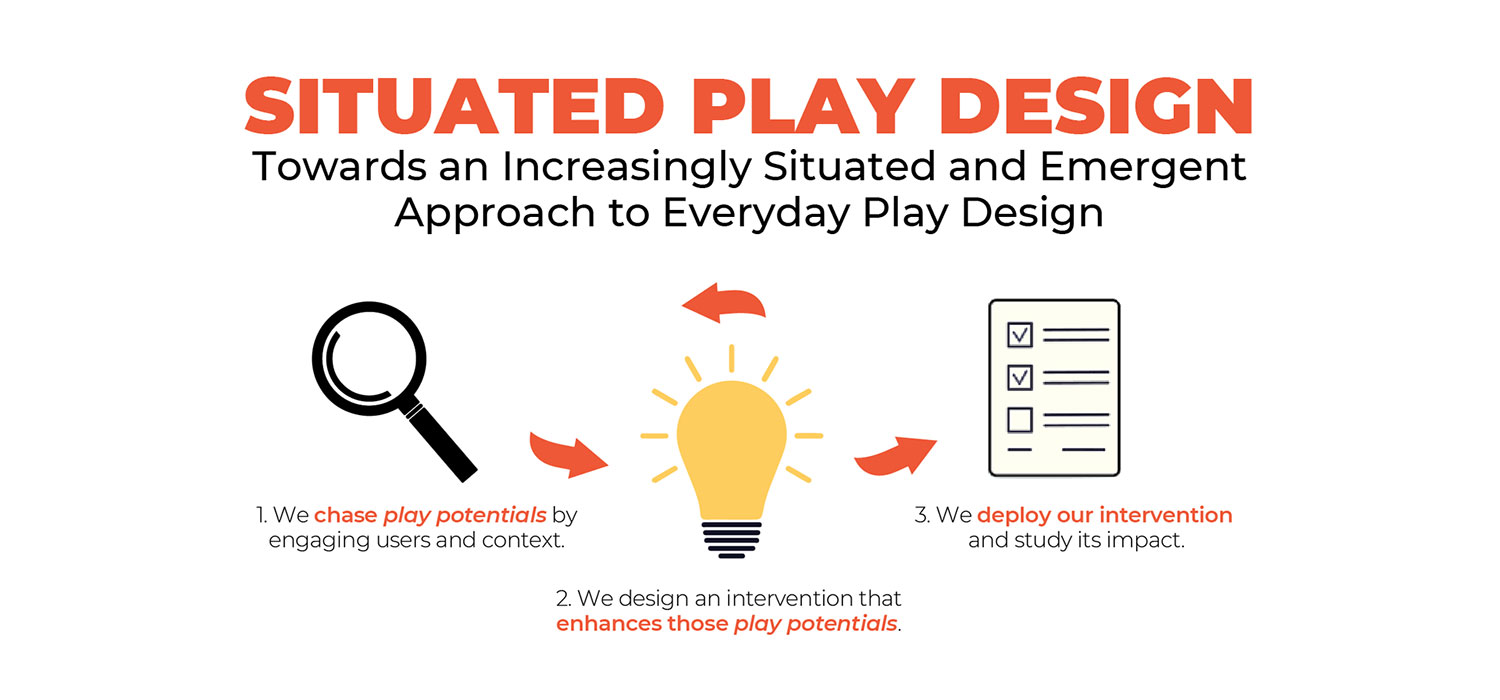
User involvement is well established in game and play design. But in a time when play design is becoming relevant in domains beyond pure entertainment, and play blends into everyday activity in diverse ways, we need to revisit old, and develop new, user involvement methods. Using a situated perspective and Research through Design, we presented Situated Play Design (SPD), a novel approach for the design of playful interventions aimed at open-ended, everyday activities that are non-entertainment based. Like user-centered game and play design methods, our contribution leverages user engagement; like Participatory Design methods, our method acknowledges the co-creating role of end users. SPD extends those approaches by focusing on uncovering existing manifestations of contextual playful engagement and using them as design material. Through two case studies, we illustrated our approach and the design value of using existing and emergent playful interactions of users in context as inspirations for future designs. This allowed us to provide actionable strategies to design for in-context playful engagement. This project was led by Ferran Altarriba Bertran and co-authored with Elena Márquez Segura, Jared Duval, and Katherine Isbister.
#Design MethodsTechnology for Situated and Emergent Play: a Bridging Concept and Design Agenda

Despite the capacity of play to spontaneously emerge in our daily life, the scope of application of play design in HCI is generally narrower, specifically targeting areas of pure leisure, or wholly utilitarian and productive play. Here we focused on the value of play design to respond to and support our natural gravitation towards emergent play that helps to meet our social and emotional needs. We developed a bridging concept: Technology for Situated and Emergent Play, i.e. technology design that supports playful engagement that emerges interwoven with our everyday activities outside leisure, and that enriches these activities with socioemotional value. Our intermediate-level contribution has value as a synthesis piece: it weaves together theories of play and play design and bridges them with concrete design examples. As a bridging concept, it contributes: i) theoretical grounding; ii) inspiring design exemplars that illustrate the theory and foreground its value; and iii) design articulations in the form of valuable experiential qualities and design features. Our work can help to focus design agendas for playful technology and inspire future designs in this space. This project was led by Ferran Altarriba Bertran and co-authored with Elena Márquez Segura and Katherine Isbister.
Chasing Play With Instagram
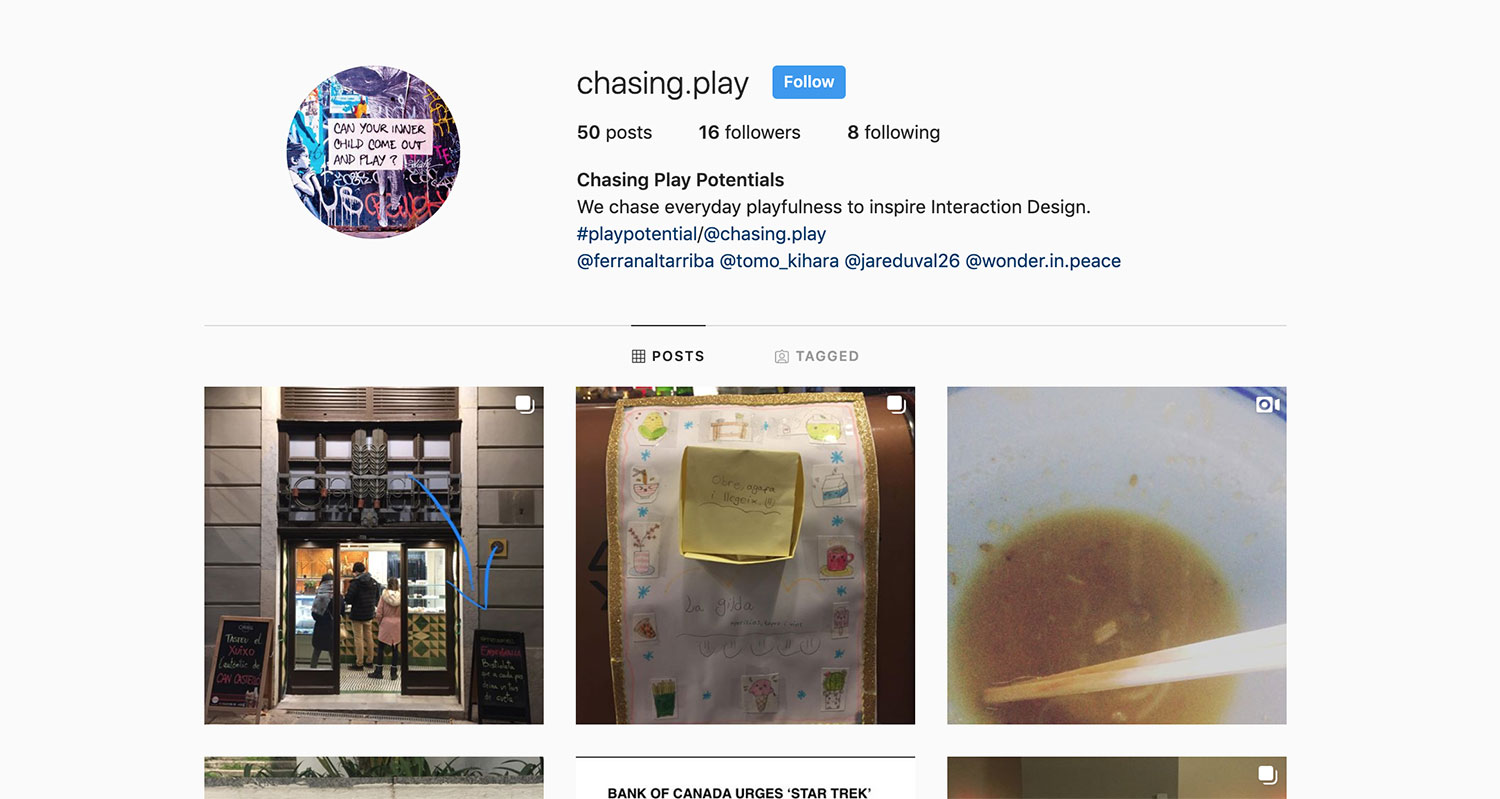
Play and playfulness permeate our daily lives and are often the target of interaction de-signers. Yet, designing for play while embracing the idiosyncrasies of users and their con-texts is challenging. Here we addressed recent calls for new situated and emergent play de-sign methods by turning to social media, which is currently a source of inspiration for arts, crafts, fashion, and more. We presented @chasing.play: an exploration of how Instagram may help designers capture and share instances of mundane playful engagement to inspire design. We reported on the findings of a pilot study where we experimented with the tool, and raise a challenges and open questions we plan to address in the future. Our work can trigger discussions among researchers about the potential of social media as a design tool, and can inspire and invite action towards collectively defining strategies to leverage that potential. This project was led by Ferran Altarriba Bertran and co-authored with Ella Dagan, Laia Turmo Vidal, Elena Márquez Segura, Jared Duval, and Katherine Isbister.
#Design MethodsMaking Sense of (Playful) Human-Food Interaction
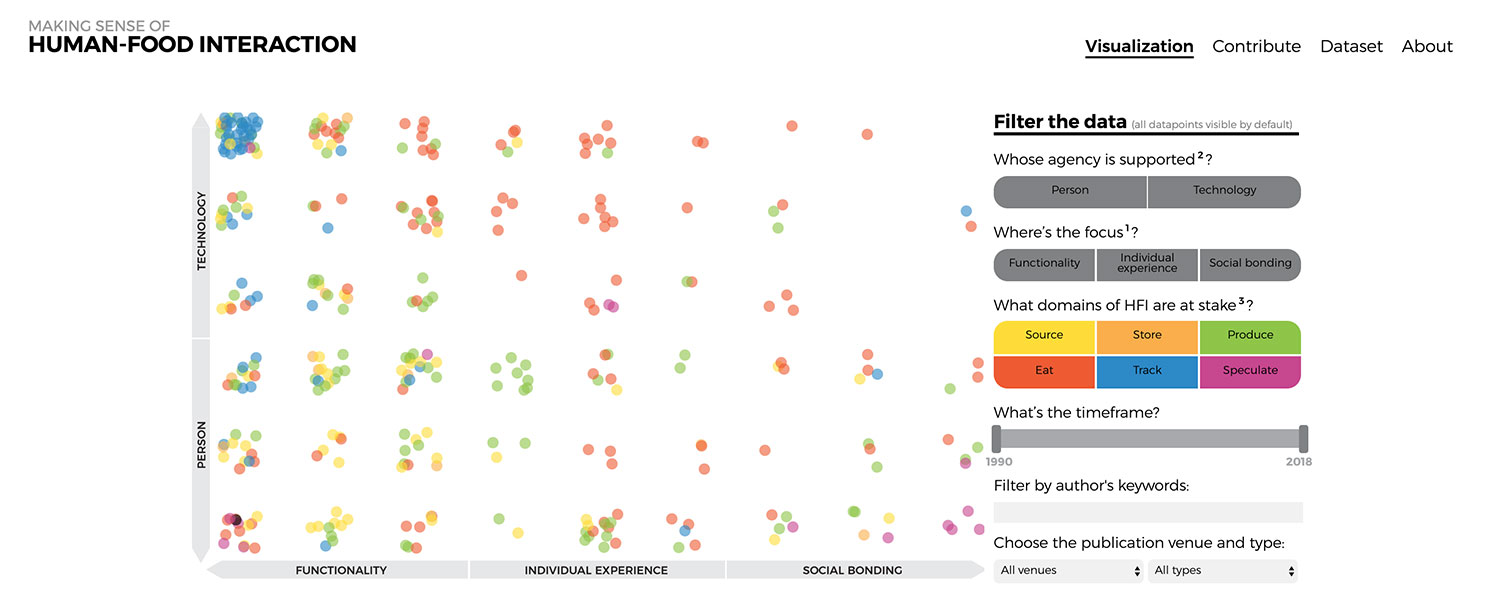
Activity in Human-Food Interaction (HFI) research is skyrocketing across a broad range of disciplinary interests and concerns. The dynamic and heterogeneous nature of this emerging field presents a challenge to scholars wishing to critically engage with prior work, identify gaps and ensure impact. It also challenges the formation of community. We conducted a Systematic Mapping Study of HFI research and developed an online data visualisation tool, the HFI Lit Review app, to respond to these issues. The tool allows researchers to engage in new ways with the HFI literature, propose modifications and additions to the review, and thereby actively engage in communitymaking. Our contribution is threefold: (1) we characterize the state of HFI, reporting trends, challenges and opportunities; (2) we provide a taxonomy and tool for diffractive reading of the literature; and (3) we offer our approach for adaptation by research fields facing similar challenges, positing value of the tool and approach beyond HFI. This project was led by Ferran Altarriba Bertran and Danielle Wilde (University of Southern Denmark), and co-authored with Samvid Jhaveri, Rosa Lutz, and Katherine Isbister. Following, we did a systematic review of a subset of HFI works that we call Playful HFI—interventions that use game- or play-inspired mechanisms to add value to foodrelated experiences. To support our review, we offer a conceptual model of Playful HFI informed by: (i) the 34 publications in our dataset; (ii) theories of play, games and HFI; and (iii) previous reviews of play-related HCI. Our conceptual model and review characterise the current state of Playful HFI, highlight resemblances and differences with the broader field of HFI as a whole and surface challenges and opportunities in this new and exciting design space. Our contribution will help HFI scholars to explore new and increasingly playful avenues for the future of food technology and will empower the HFI community to better position (and critically reflect on) future research at the intersection of play, technology and food. This project was led by Ferran Altarriba Bertran and Danielle Wilde (University of Southern Denmark), and co-authored with Ernö Berezvay (Open University) and Katherine Isbister.
Chasing Play Potentials in Food Culture and Traditions
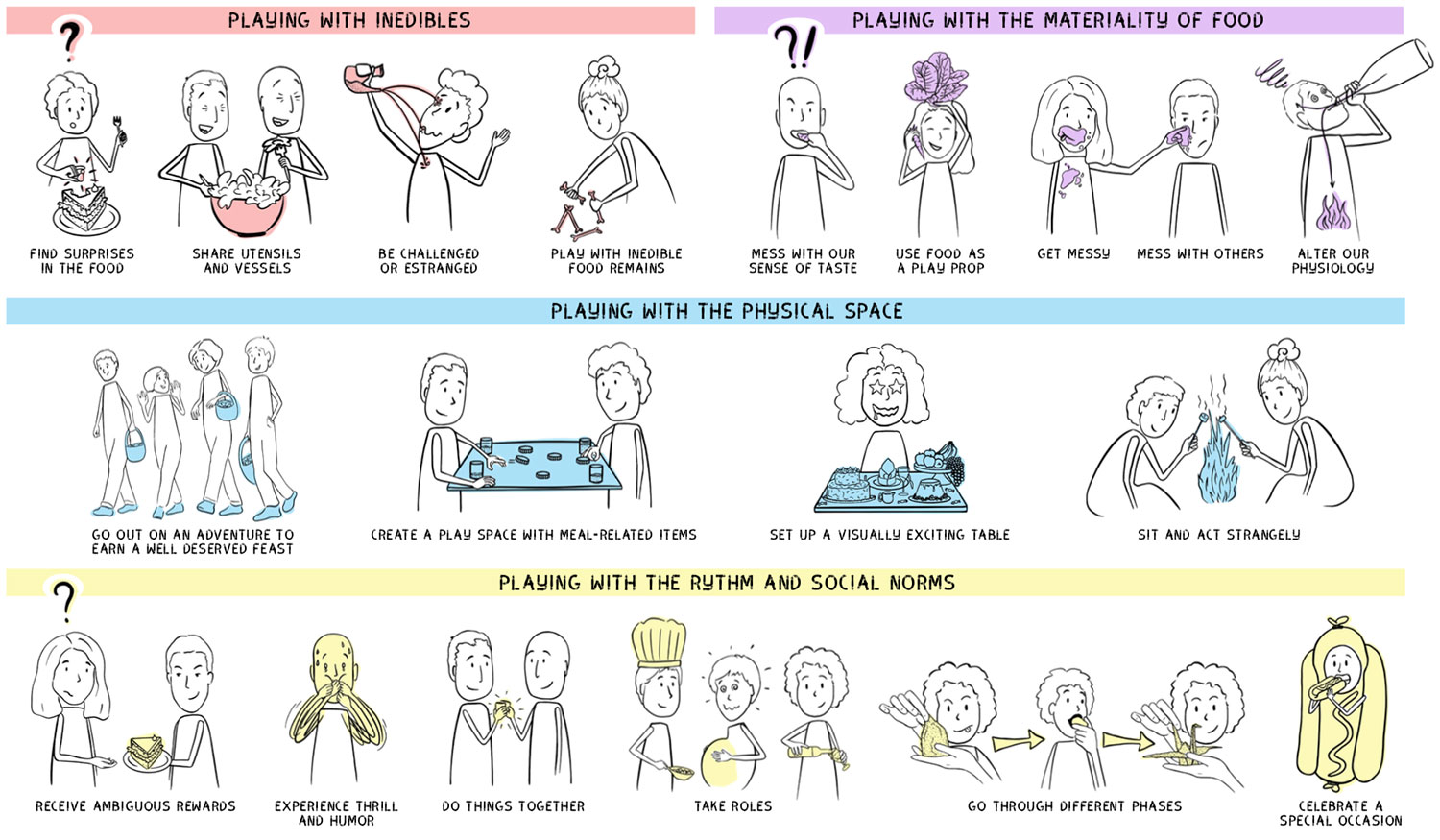
In this project, we turned to culture and traditions to produce an annotated portfolio of play-food potentials, i.e. interesting design qualities and/or interaction mechanisms that could help promote playful and social engagement in food practices. Our portfolio emerged from a one-day workshop where we played with and analyzed a collection of 27 food traditions from diverse cultural backgrounds and historical periods. We highlight play forms and experiential textures that are underexplored in Human-Food Interaction (HFI) research. Our contribution is intended to inspire designers to broaden the palette of play experiences and emotions embraced in HFI. This project was led by Ferran Altarriba Bertran and co-authored with: Jared Duval, Elena Márquez Segura, Laia Turmo Vidal (Uppsala University), Yoram Chisik (Independent Researcher), Marina Juanet Casulleras (Freelance Illustrator), Katherine Isbister, and Danielle Wilde (University of Southern Denmark).
Experimental Food Design and Research

Recognising the need for increasingly critical approaches to Human-Food Interaction research, we joined forces with researchers from other universities to co-found the Feeding Food Futures (FFF) network. FFF is a collective of Human-Food Interaction (HFI) researchers, designers, practitioners, and (human and non-human) eaters exploring the intersection between food, technology, and culture. We design experimental HFI tools and events to provoke material reflections of contemporary human-food-technology ecosystems, with a broad take on what constitutes technology. We aim to nurture critical and playful HFI approaches that support participatory human-food engagements rather than ready-to-use solutions. This project, and the many initiatives it encompasses, was initiated by Ferran Altarriba Bertran in collaboration with Markéta Dolejsova (Aalto University), Danielle Wilde (University of Southern Denmark), and Hilary Davis (Swinburne University of Technology).
#Design MethodsPlayful Gastronomy

Socialisation, eating and play are core activities that make us human. While they are often brought together, play theory suggests that their combination has unexplored potential in the context of gastronomy. Our research also indicates that a chef’s desire to control the meal may be a key impediment to developing dining experiences in which the diner’s playful engagement impacts taste, texture and flavour combination. In this project, we investigate if combining participatory Research through Design and play theory might better situate chefs to diversify their approach to playful gastronomy. This project is led by Ferran Altarriba Bertran, and co-authored by Danielle Wilde (University of Southern Denmark), Rosa Lutz, and Katherine Isbister.
#Design MethodsSpokeIt
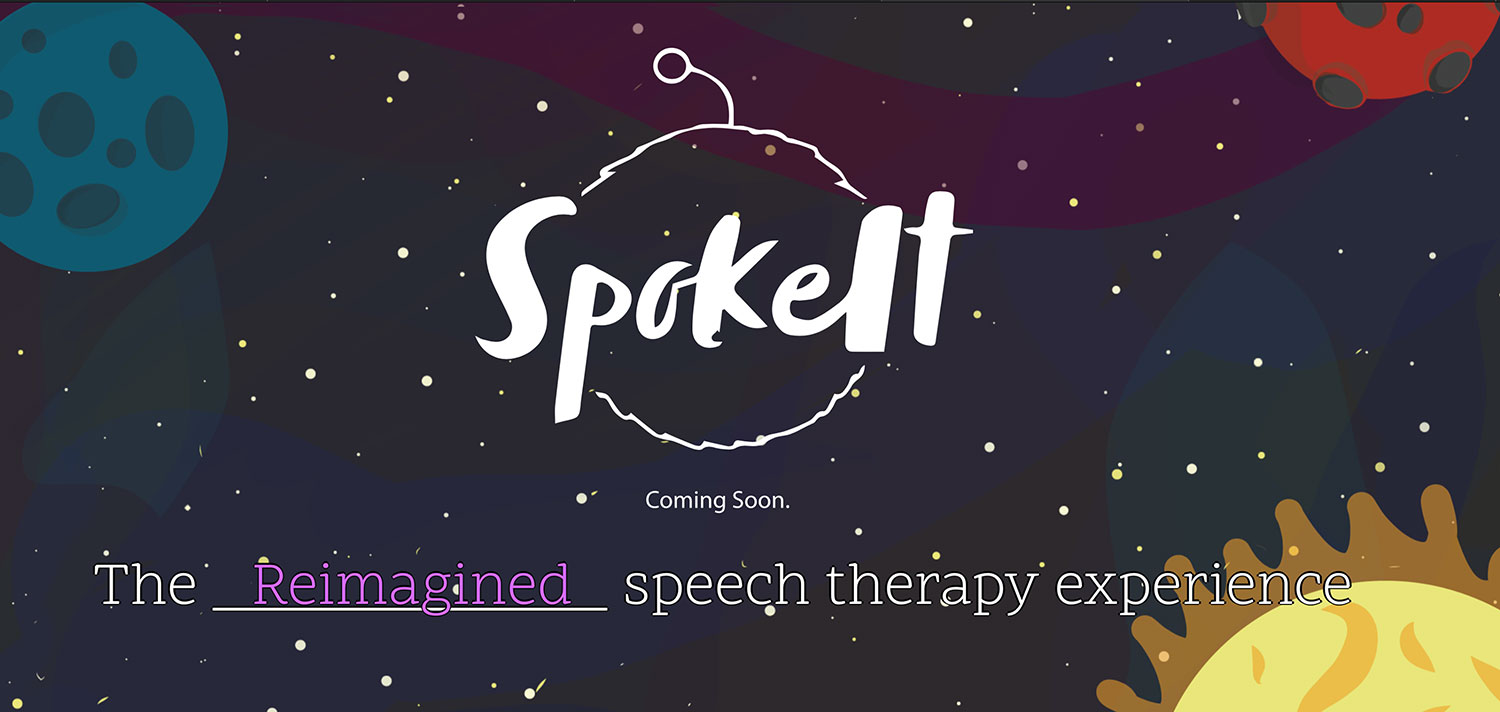
SpokeIt addresses the needs of a large community of people who receive, do not receive, or provide speech therapy. SpokeIt is a serious game for heatlh designed to provide at-home speech therapy and engaging activites. Speech practice at home is usually hindered by a lack of intrinsic motivation due to the tedious and repetitive idiosyncratic nature of speech therapy curriculums. Parents and caretakers experience major difficulties prompting individuals to complete speech exercises at home, especially when young. They often lack the expertise of a speech therapist and report a general low sense of competence in facilitating curriculum. Medical professionals have little insight into the (lack of) progress outside of their practice and would benefit from reports. SpokeIt is intended to be used by children aged 4-10 with cleft speech, as well by parents, caretakers, and medical professionals for curriculum customization, progress reports, and integrated at-home play.
Social VR Research
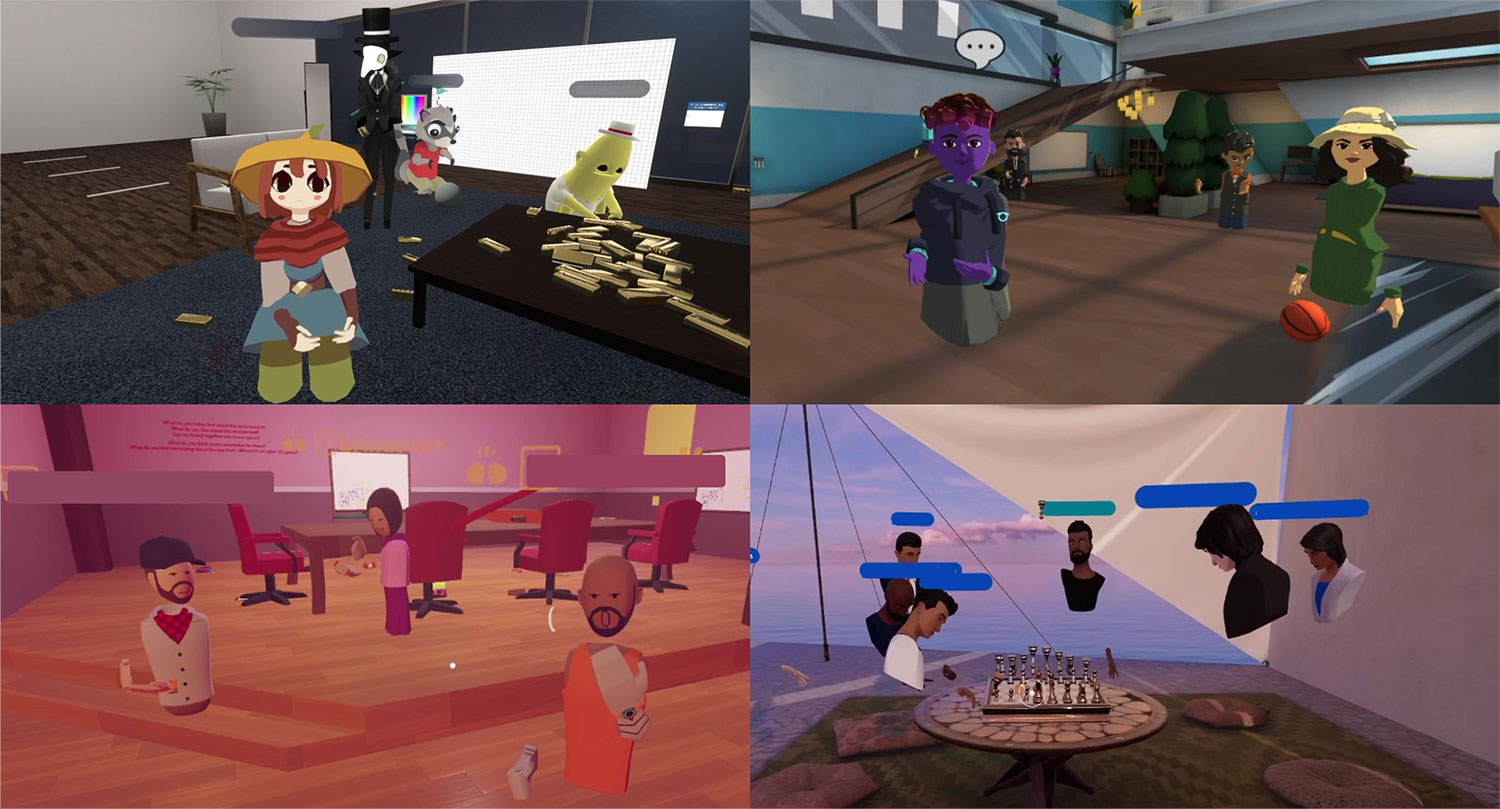
This project explores building social VR technology to improve networked meetings. VR shows promise as a technology for supporting remote meetings in new ways because it puts team members in a shared media space, which allows for familiar communication tactics. This project focuses on design and development of social VR tools to improve face-to-face meetings by helping participants time manage, come to decisions, stick to an agenda, and achieve social connection and support for ideas. These innovations seek to make online meetings more effective and satisfying. This work was supported by the National Science Foundation under Grant No. 2007627 and No. 2007755
#Social Augmentation#Social VRUnderstanding Emerging Design Practices for Avatar Systems in the Commercial Social VR Ecology
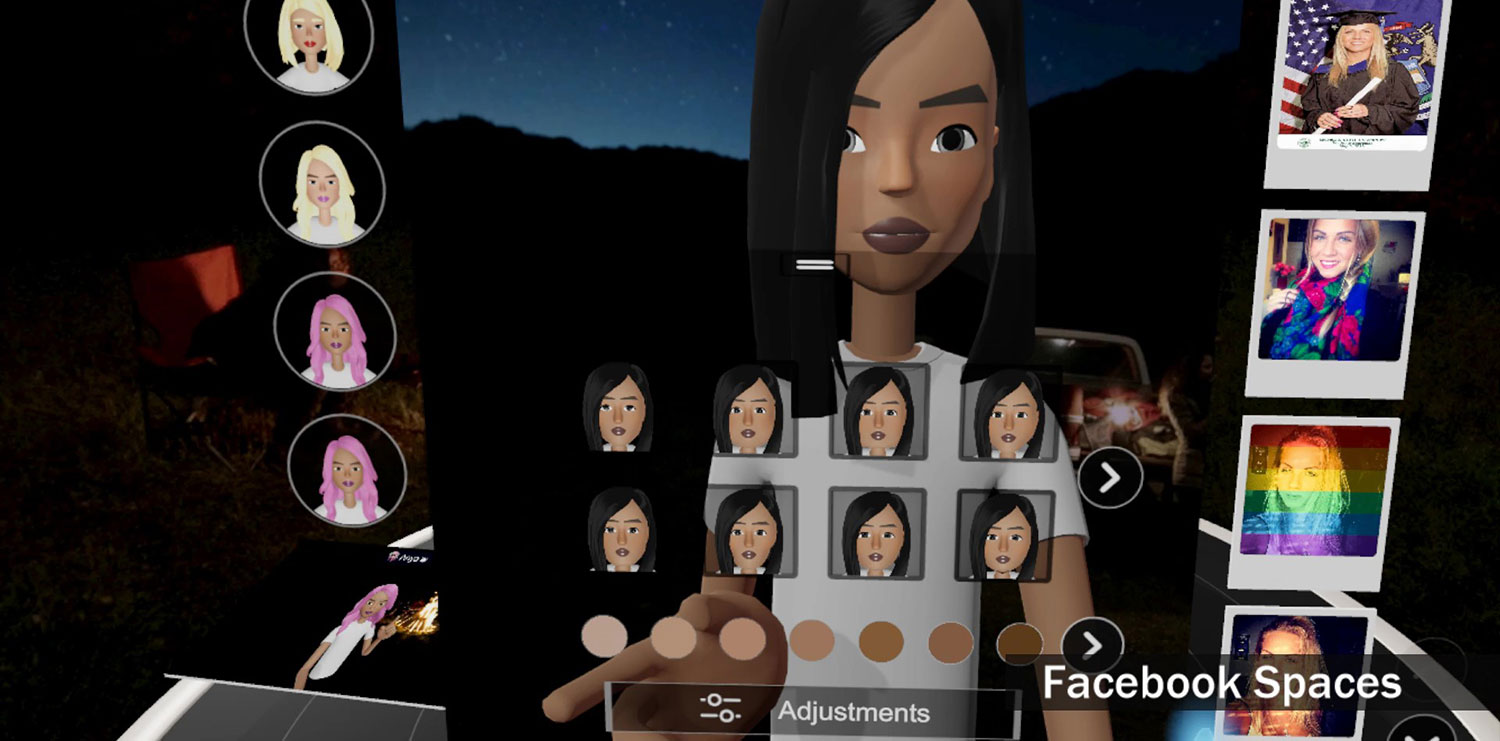
In the emerging ecology of commercial social VR, avatars that serve to represent individuals within these multi-user virtual worlds are at the heart of the embodied social experience. Current industry approaches to avatars in social VR applications vary widely, and the (sometimes tacit) design knowledge acquired by those who created these platforms has much to offer research in HCI. In this paper, we describe current design practices, and reflect on the design approaches that characterize avatars and avatar systems in this emerging commercial sector. To investigate design approaches to avatar systems and their impact on communication and interaction with people within this medium, we interviewed industry experts associated with a range of platforms including Rec Room, AltspaceVR, High Fidelity, VRChat, Anyland, and Mozilla Hubs. In analyzing the ways that design choices shape embodied experience, we map design approaches to avatar systems in this evolving landscape and make preliminary claims about the impact of these varying design approaches.
#Social Augmentation#Social VRWhat's it Mean to 'Be Social' in VR? Mapping the Social VR Design Ecology
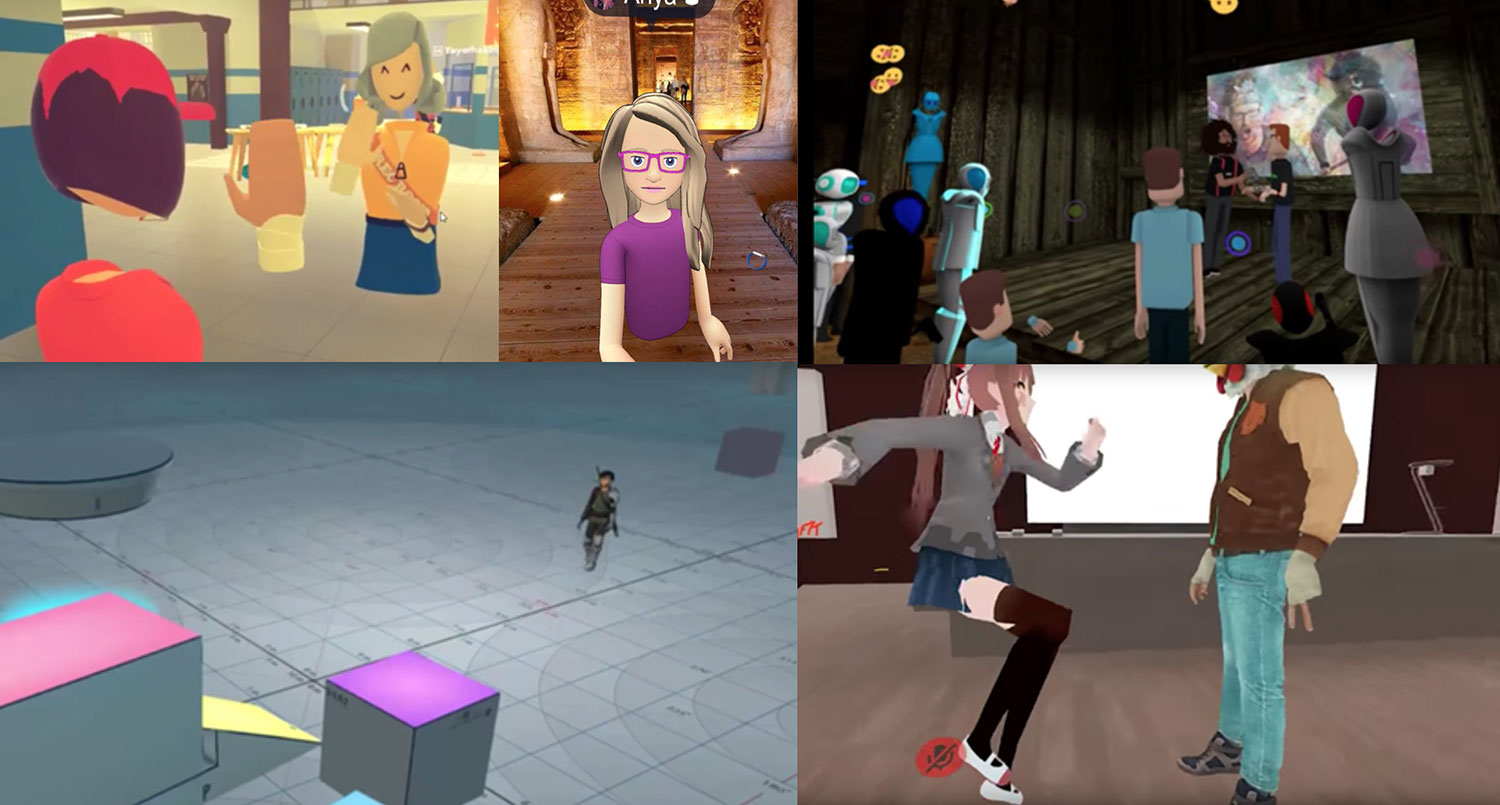
The emerging ecology of commercial social VR currently includes a diverse set of applications and competing models of what it means to be social in VR. This study maps a slice of this ecology, comparing and contrasting ways different applications frame, support, shape, or constrain social interaction. We deploy a method of design-oriented autobiographical landscape research to examine five platforms: Facebook Spaces, Rec Room, High Fidelity, VRChat, and AltspaceVR. We analyze design choices underlying these environments and draw attention to issues of space and place, locomotion, and social mechanics. Drawing on this analysis, we identify key issues and concerns for future research and design in social VR.
#Social Augmentation#Social VRShaping Pro-Social Interaction in VR: An Emerging Design Framework
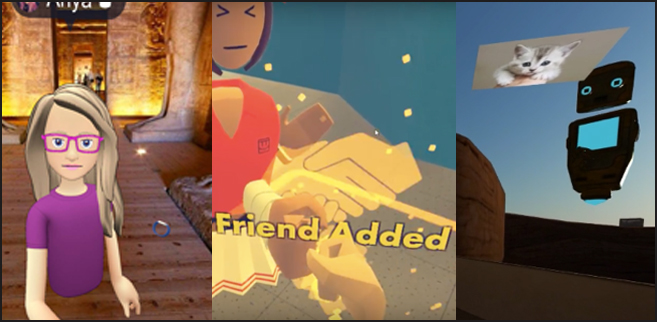
Commercial social VR applications represent a diverse and evolving ecology with competing models of what it means to be social in VR. Drawing from expert interviews, this paper examines how the creators of different social VR applications think about how their platforms frame, support, shape, or constrain social interaction. The study covers a range of applications including: Rec Room, High Fidelity, VRChat, Mozilla Hubs, Altspace VR, AnyLand, and Facebook Spaces. We contextualize design choices underlying these applications, with particular attention paid to the ways that industry experts perceive, and seek to shape, the relationship between user experiences and design choices. We underscore considerations related to: (1) aesthetics of place (2) embodied affordances, (3) social mechanics, (4) and tactics for shaping social norms and mitigating harassment. Drawing on this analysis, we discuss the stakes of these choices, suggest future research directions, and propose an emerging design framework for shaping pro-social behavior in VR.
#Social Augmentation#Social VRConversation Balance: A Shared VR Visualization to Support Remote Meetings
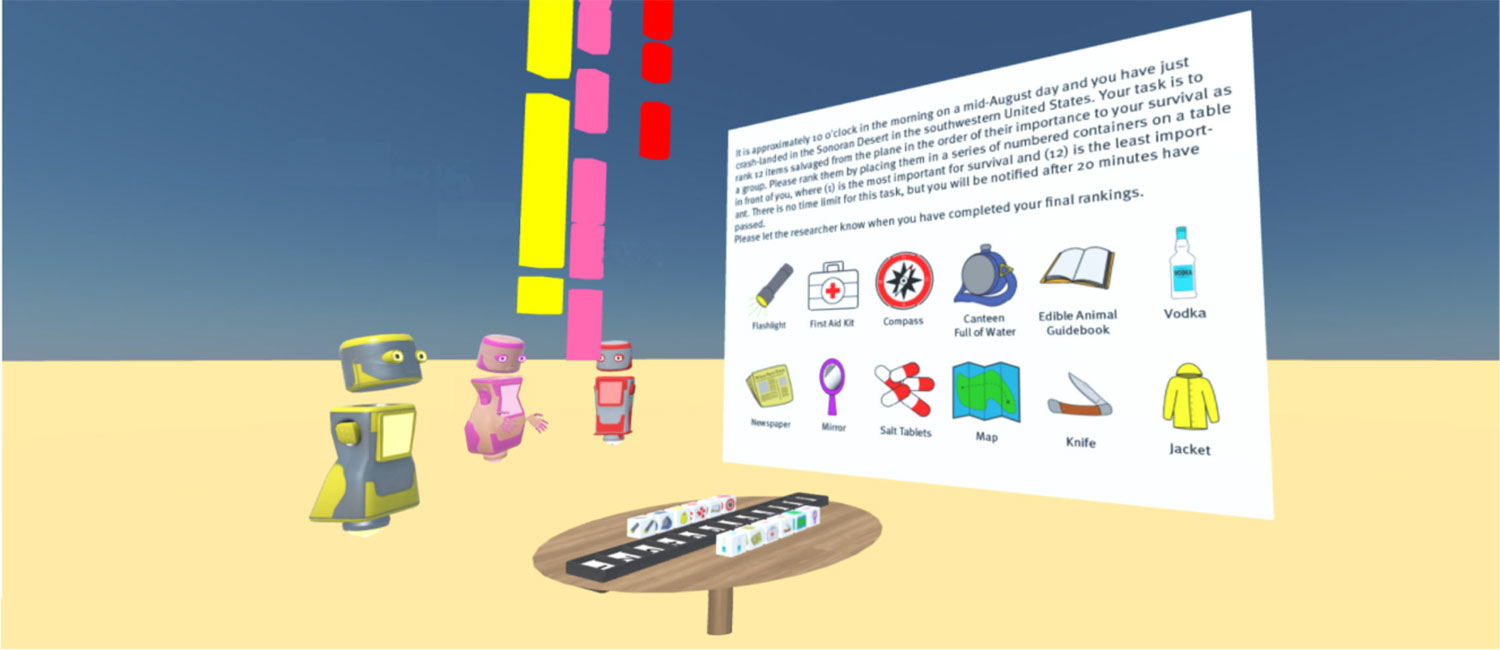
Since the spread of COVID-19, the world has pivoted to a remote working lifestyle, where people’s work lives are connected everyday through distributed technologies. This interactivity demonstration provides users with a visualization of their conversational turn-taking, within a shared Virtual Reality (VR) environment. It is intended to help support balanced communication in remote meetings. Project contributors include UCSC MS students Victor Jialang Li and Sean Fernandes, Ph.D. students Anya Osborne and Max Kreminski, undergraduate students Tara Lamb and Sarah Banks, as well as researchers working with SF State professor Joshua McVeigh-Schultz, including George Butler.
#Social Augmentation#Social VRAstaire
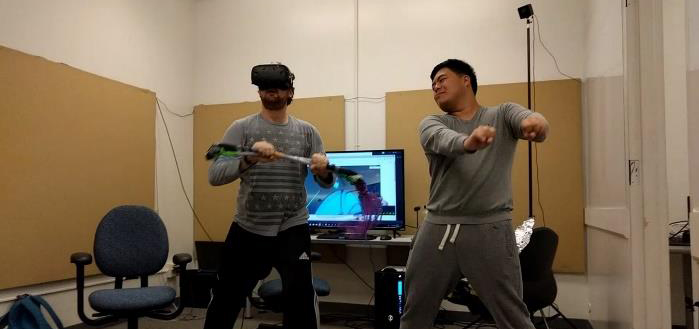
Astaire is an asymmetric collocated virtual reality (VR) game designed with the intent to encourage pro-social play in festival/home settings and provide a better spectator experience than other games. The overall goal of the game is to get the highest score possible by tagging musical notes and footsteps as quickly as you can with your controller, as they appear on beat with the music. Players are rewarded with more points the faster they tag the notes, and each interactable object within the world has a generous hitbox to create a more fluid experience, in that players should not have to struggle because the controllers are not attached to their feet or hands. It is designed to allow for 2 players to use 1 system simultaneously to play, both with different objectives and roles to consider (hence the asymmetry). The players have distinct sources of information. The player with the controller attached to their leg uses the television for guidance, as the view there is from an overhead camera above the map that shows notes that are only interactable with the controller attached to the other player 1 second before they spawn. The player inside VR can see both players’ notes, but not with the foresight or breadth of the other player. They see the footstep notes only interactable for the player outside VR, which they can then guide them to.
#Social Augmentation#Social VRSceneSampler
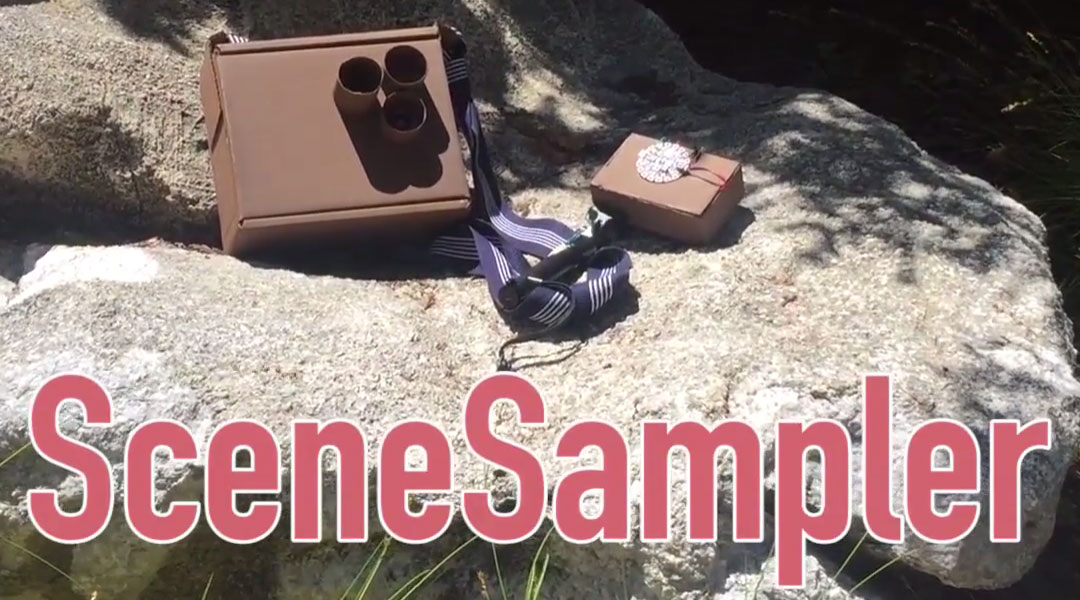
SceneSampler pushes the boundaries of local multi-player games. We’ve created our own gadgets –a wearable ‘camera’ and a handheld sound ‘sampler’– that players use collaboratively to capture brief slices of the scene (people hanging out, enjoying games, catching up) as the festival goes on. The core mechanic –seeking out particular kinds of sounds– pushes players to move around together in the social space in a playful way that’s different than they might otherwise. The game leaves traces of the festival in the form of player snapshots shared digitally –these create a secondary kind of play in the social media surrounding the festival. Overall, SceneSampler is meant to enhance the social experience of being at a game festival like IndieCade, making a game of exploring the human landscape and capturing moments for others to enjoy and remember.
#Social AugmentationAll the Feels
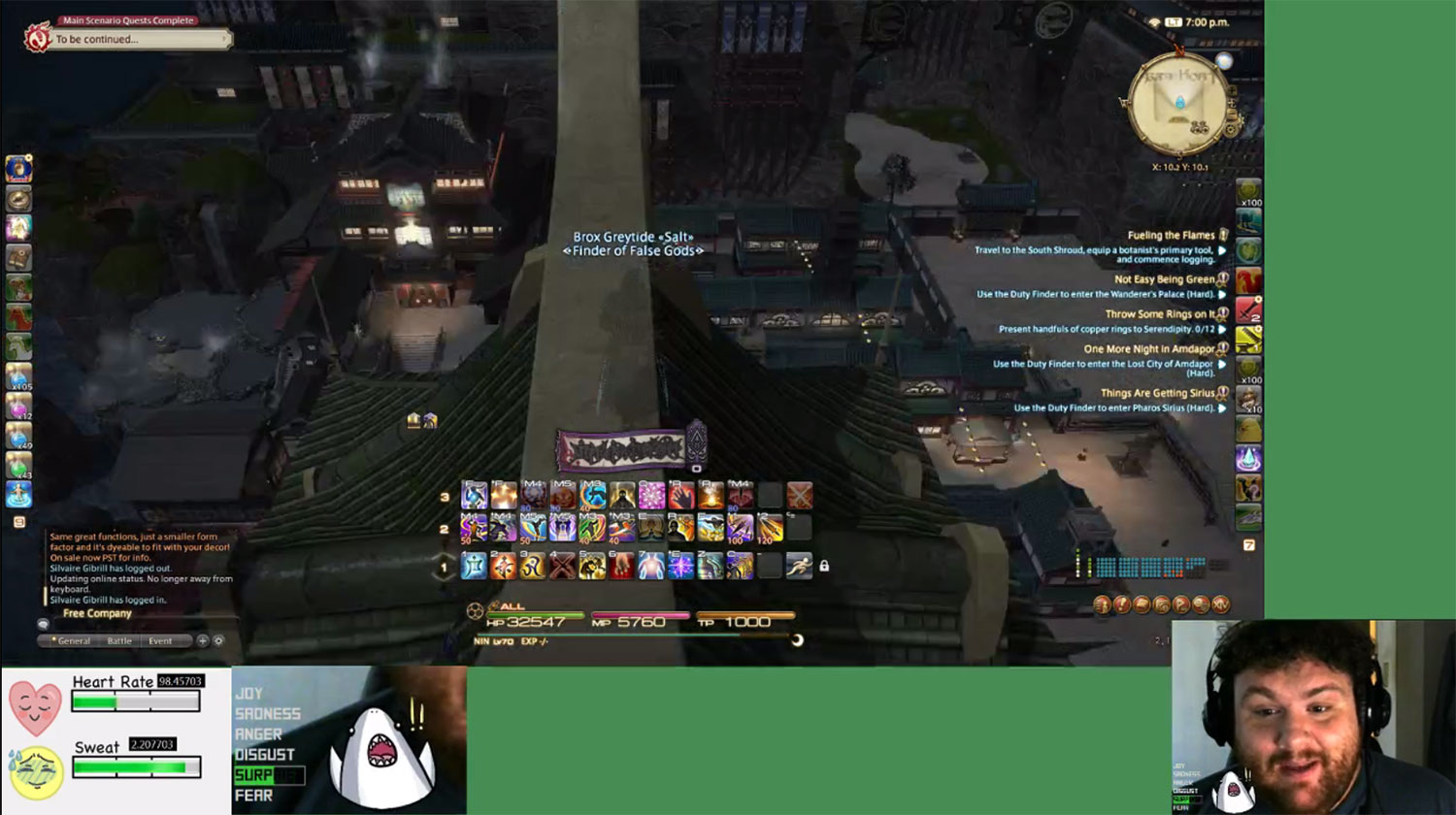
This project is called All the Feels, which is a tool that provides an overlay of biometric and webcam-derived data onto the interface of the popular video game streaming service, Twitch. The overlay provides visualization of heart rate, skin conductance, and facial emotion recognition. It is intended to enhance the spectator experience and improve streamer-spectator connection. This work opens up opportunities to improve stream quality and spectator engagement through the introduction of an interface that includes biometric signals. Janell Mora was responsible for the all the art used in the overlay, and April Grow provided consultation on the research.
#Social AugmentationIn the Same Boat
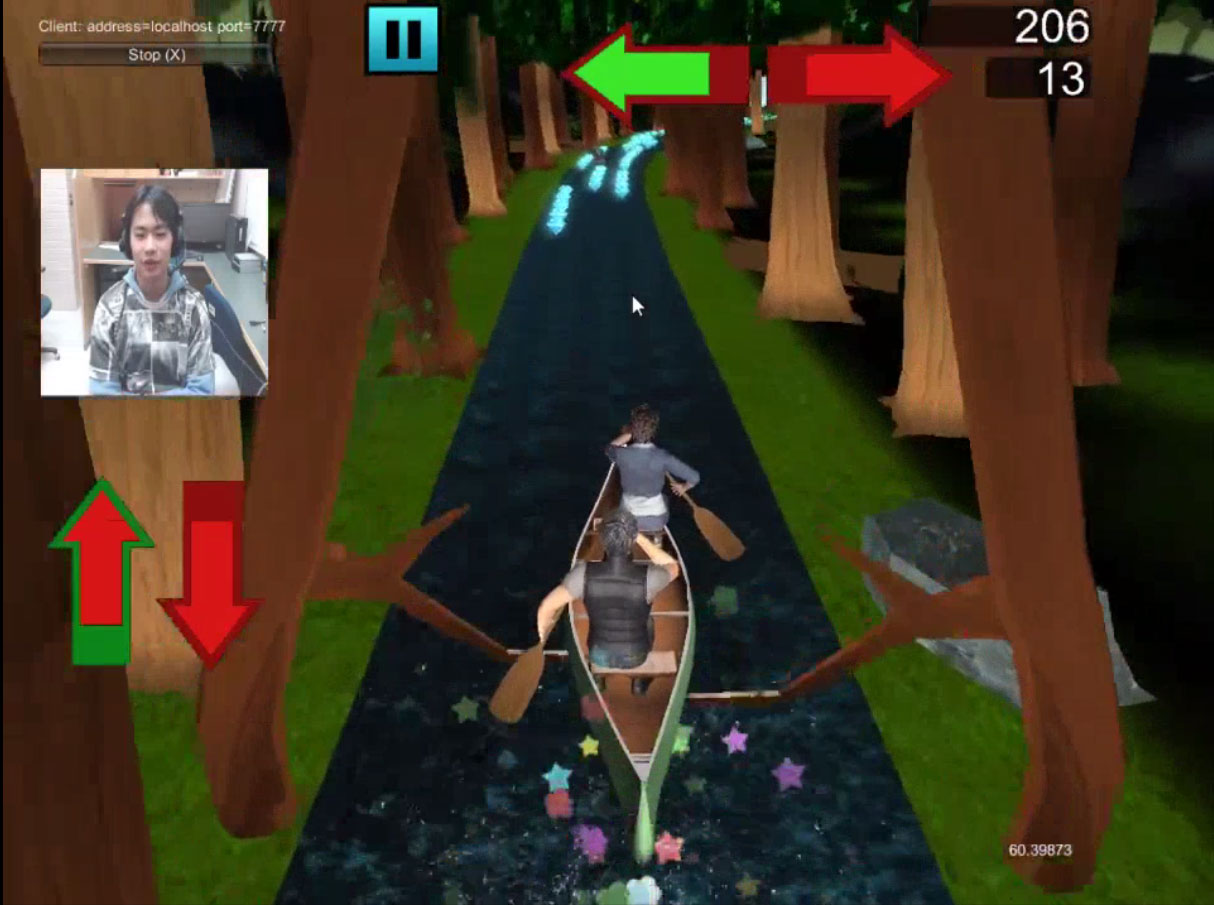
Social closeness is important for health and well-being, but is difficult to maintain over a distance. Games can help connect people by strengthening existing relationships or creating new ones through shared playful experiences. The name of this project/game is, 'In the Same Boat' (ITSB), which is a two-player infinite runner designed to foster social closeness in distributed dyads. ITSB leverages the synchronization of both players' input to steer a canoe down a river and avoid obstacles. We created two versions: embodied controls, which use players' physiological signals (breath rate, facial expressions), and standard keyboard controls. This was was a collaboration between UCSC and the University of Saskatchewan. Elizabeth Reid implemented the game, James Fey built the hardware, and Ansgar Depping provided design consultation.
#Social AugmentationYou're Giving me Mixed Signals!

In this project, we conducted a comparative analysis of several emotional reporting techniques for assessing gameplay experience. We compared newer feedback methods, such as the Sensual Evaluation Instrument (SEI) and recent tools for capturing physiological data, with more traditional techniques such as think-aloud, the Immersive Experience Questionnaire (IEQ), and retrospective interviews. Findings suggested that mixed methods offer complementary strengths in registering player emotion, are useful at different moments of play, and help to accommodate differences in the ways players' emotions manifest. We argue for the value of using multiple methods in evaluating players' emotional response to games. This work was done in collaboration with John Murray.
#Social AugmentationChildren's Fidget Object Preferences

Fidgeting involves interacting with objects using repetitivehand movements. Before you can study its effects, you mustfirst study the objects with which people choose to fidget.We present the findings of our five-phase three-month studywith 28 children, 24 parents, and 2 teachers examining fidgetmaterial qualities and inherent interactions children gravitatetowards when fidgeting and what, if any, connections can bemade between their emotional state or activity when fidgetingand their fidget interactions/materials preferences. Our studyincluded structured interviews, observations during usage, anddesign workshops. We present novel insights concerning fidgetobject preferences, across factors including materials, inter-actions, stealth, durability and sound, which together can actas guidelines in the development of educational, experimentaland utility tangibles for children. For example, children tendto prefer a fidget item with inherent squeezing interactionswhen they are angry and clicking/pressing/tapping interactionswhen they are bored. This project was lead by Suzanne B. da Câmara and co-authored with Rakshit Agrawal and Katherine Isbister.
#Self RegulationSoft-bodied creature for enriched SEL engagement
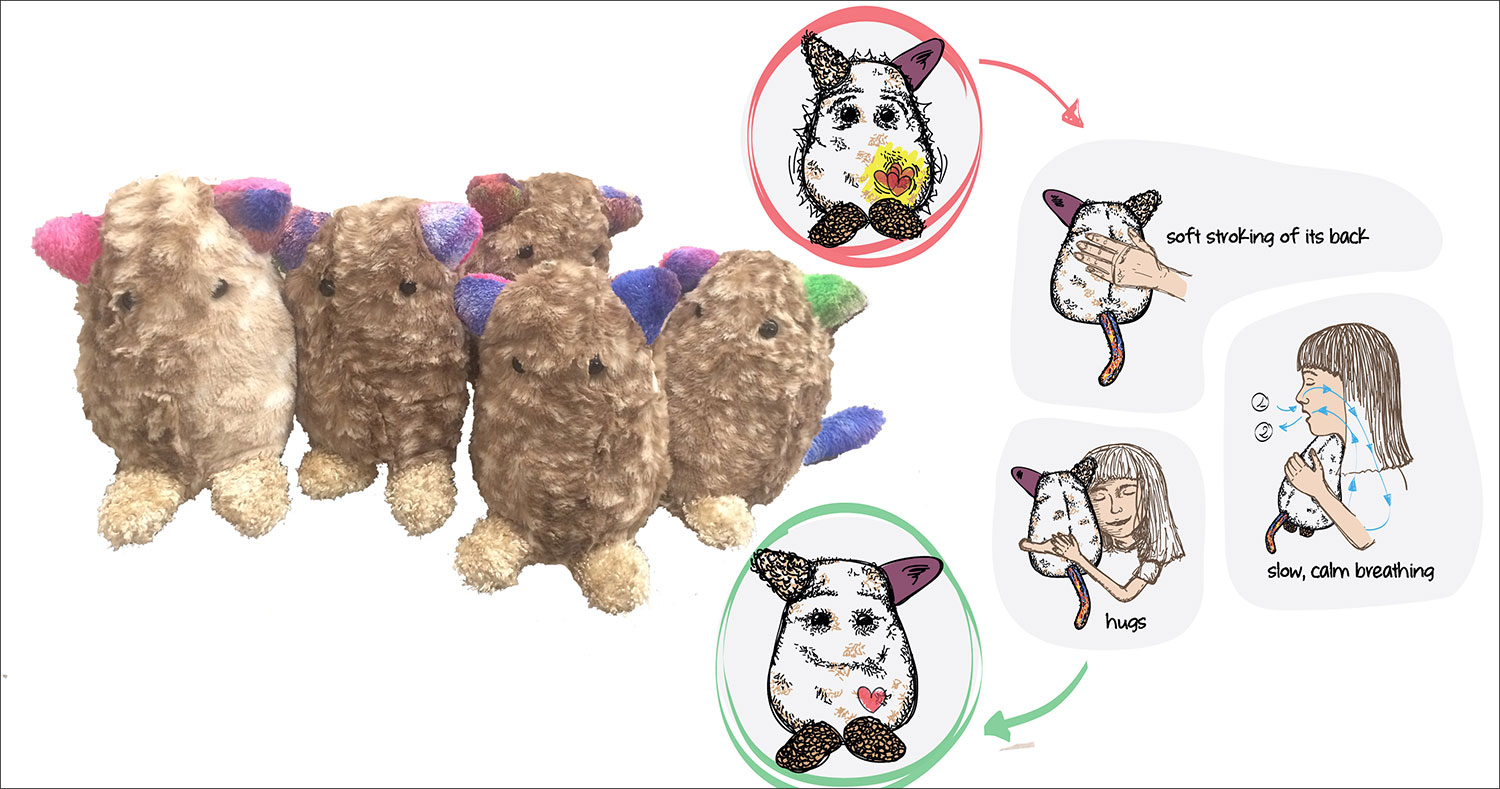
This exploration is an extension of the work started in our Smart Materials exploration and looked at designing a companion that would endear itself to a child. It was aimed at encouraging healthy self soothing in the child through vibrational feedback and has the ability to respond when it's being interacted with. In addition it's self contained on board cataloging allows for post reflection on the actions the child performed. In this Research-Through-Design process we created several iterations and focus tested, workshopped and eventually deployed them into the field with children that were actively in Social and Emotional Learning courses. This was a multiyear deployment and production of the creature involved Peter Cottrell, Alessia Cecchet, Ella Degan, and Katherine Isbister at UCSC. We partnered with UCL and CfC to deploy the creature to the children.
#Self RegulationSoft-bodied object for observing fidgeting
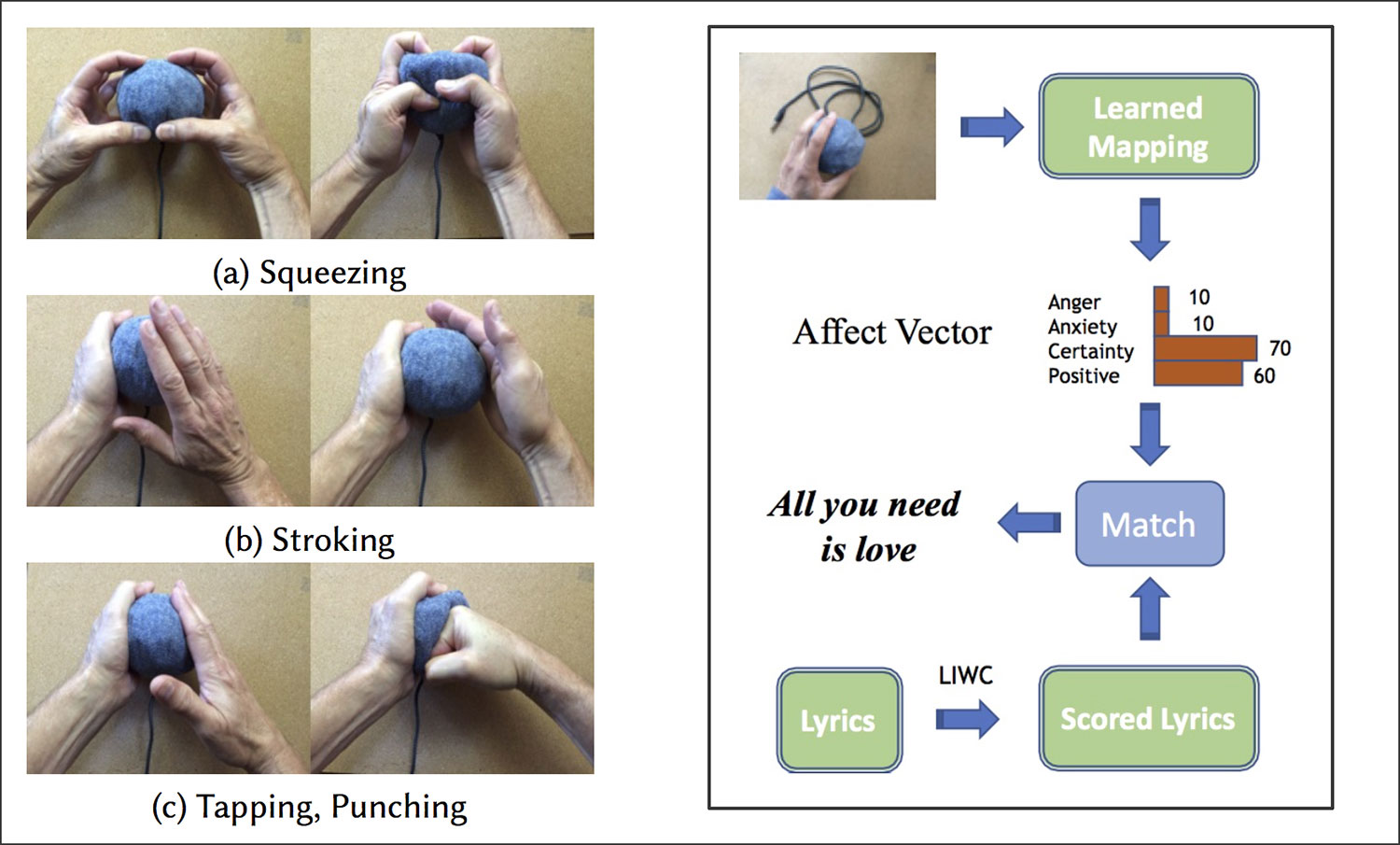
Observing fidgeting is hard when you're attempting to do so naturally, however our team took the approach of using the fidgeting object to observe the user rather than external observers interpreting behavior. In this project we developed a soft-bodied ball that has internal hardware designed to absorb user interaction through pressure, gyroscope and "clicky" buttons to allow for a wide range of fidgeter fascination. This device is being used in collaboration with Machine Learning designers who have developed translation engines from touch into affect and touch into visual feedback. This project is in flux and has several end goals to explore. It is a collaboration between Peter Cottrell, Alessia Cecchet, Ella Degan and Katherine Isbister, with help from undergraduates Vicky Feng, and Neilson Pacquing. Our external collaborators include UCSC ML Professor Daniel Shaprio and Dr. Julie B Schweitzer and Shannon Hoffman from the UC Davis MIND Institute.
#Self RegulationMaterials Exploration for Smart Fidgeting
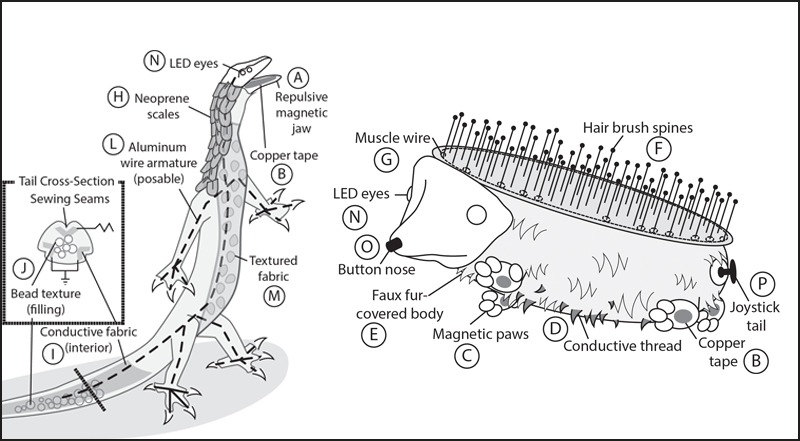
This materials exploration into how we might integrate electronics into interesting fidgeting modalities and material interfaces was derived from work published in Karlesky and Isbister (NordiCHI '16). Our team used a research through design method to prototype and explore various embedded electronics resulting in 2 exemplar devices in the shape of a dragon and a hedgehog. These prototypes were presented to a workshop of children alongside other fidgeting devices (see da Camera CHI 2016 for more information on user study). This project was developed by Peter Cottrell, April Grow and Katherine Isbister.
#Self RegulationPIV++: Evaluating a Personalizable, Inconspicuous Vibrotactile (PIV) Breathing Pacer for In-the-Moment Affect Regulation

We designed and evaluated a personalizable and inconspicuous vibrotactile breathing pacer. We developed the pacer to help people regulate their anxiety. We examined two previously unstudied questions: what is an effective vibrotactile pattern for paced breathing, and where should the tactors be placed on the body to make the pacer most effective? We designed a series of personalized vibrotactile pacing patterns, and evaluated them on three body sites, in terms of self-reported and psychophysiological measures including skin conductance (SC) and breath wave parameters. The results show that personalization plays an important role in PIV’s pattern and placement design choices and we concluded that the choice of frequency based vibration patterns and abdomen placement are appropriate for future studies. Given the prevalence and adverse impact of anxiety, there is considerable interest in using technology to regulate anxiety. Evaluating the efficacy of such technology in terms of both the average effect (the intervention success) and the heterogeneous effect (for whom and in what context the intervention was effective) is of paramount importance. In this paper, we demonstrate the efficacy of PIV, a personalized breathing pacer, in reducing anxiety in the presence of a cognitive stressor. This is the first mixed-design study of a vibrotactile affect regulation technology which accounts for individual differences and user-technology engagement in relation to the technology’s efficacy in the presence of a specific stressor. Guidelines in this paper can be applied for designing and evaluating other affect regulation technologies.
#Self RegulationHapLand: A Scalable Robust Emotion Regulation Haptic System Testbed
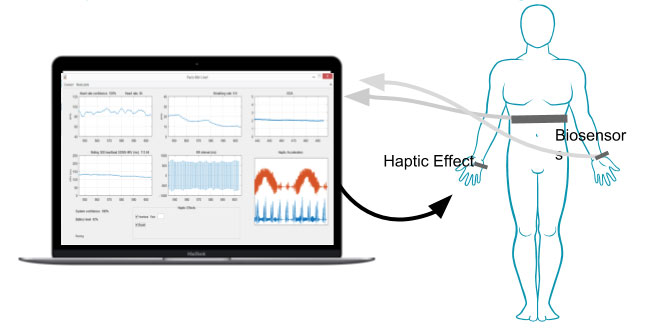
In this project, we have designed and implemented HapLand, a scalable, robust biofeedback haptic system testbed to facilitate research-based haptics-enabled wearables design for the purpose of emotion regulation.
#Self RegulationEmotion Regulation in the Wild: Introducing WEHAB
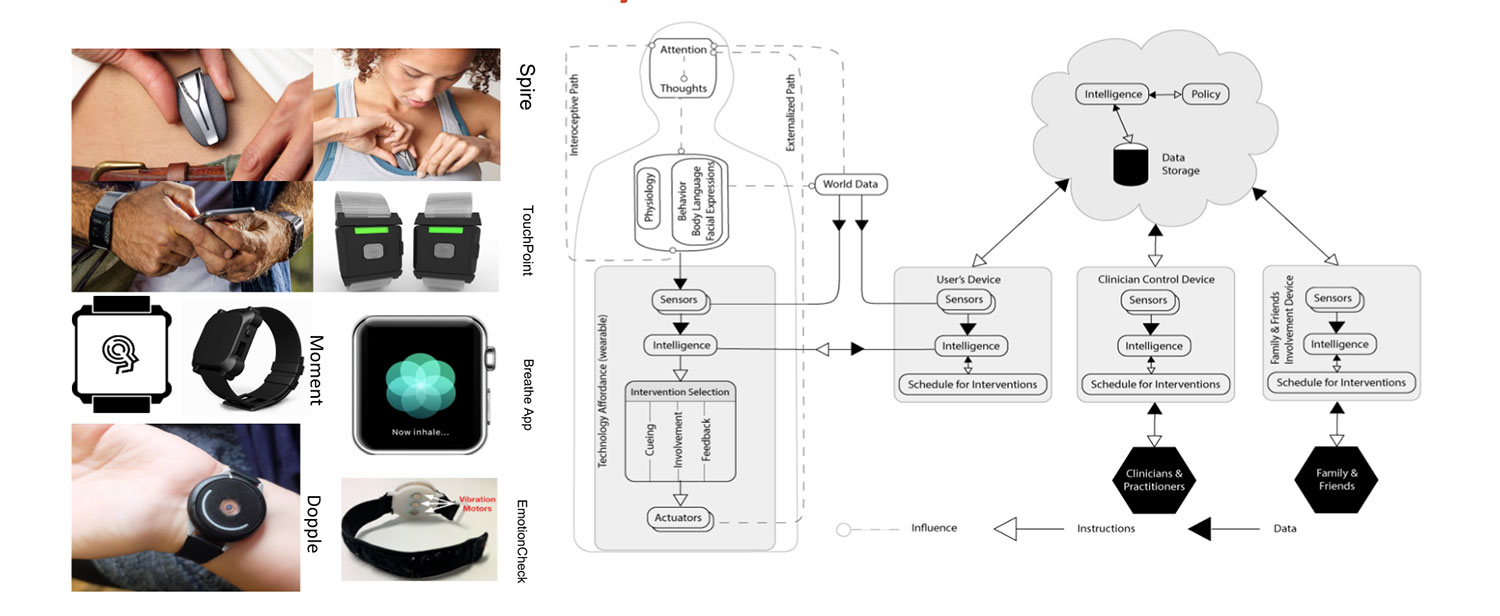
Emotion regulation in the wild (ER-in-the-wild) is an important grand challenge problem of increasing focus and is hard to approach effectively with point solutions. We provide HCI researchers and designers thinking about ER in-the-wild with an ER-in-the-wild system architecture derived from mHealth, the Emotion Regulation Process Model(PM), and a circular biofeedback model that can be used when designing an ER system.
#Self Regulation